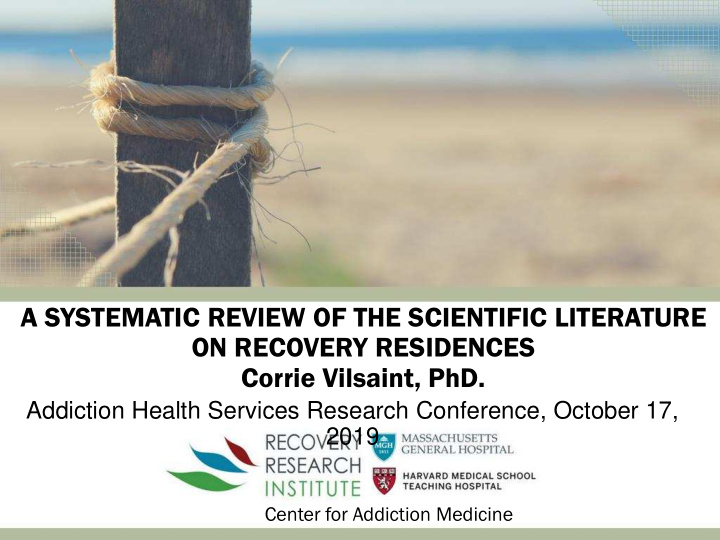



A SYSTEMATIC REVIEW OF THE SCIENTIFIC LITERATURE ON RECOVERY RESIDENCES Corrie Vilsaint, PhD. Addiction Health Services Research Conference, October 17, 2019 Center for Addiction Medicine
Overview • Purpose, scope, prevalence • Inclusion criteria and search results • Results from 22 articles and four models: • Oxford House • Sober Living Homes • Recovery Housing • Halfway Houses • Summary of Findings
RECOVERY RESIDENCES Nature & Scope • Recovery residence is a sober, safe, and healthy living environment that promotes recovery from alcohol and other drug use and associated problems (National Association of Recovery Residences, NARR). • Offer peer and abstinence support, some provide professionally delivered clinical services. • Sober living, halfway house, three-quarter house or transitional house. • Residents often engage in (Dept. Health and Human Services, 2016) : -decision making -facility management -financial self-sufficiency -informal case management for each other -advice on how to access health care -find employment -manage legal problems -interface with the social service system
RECOVERY RESIDENCES Origin & Prevalence • Over 100 years old. • NARR is the largest recovery housing organization, supports more than 25,000 persons in recovery across 2,500 certified recovery residencies in 26 states. • 22.6 million people who have resolved a problem with alcohol or other drugs, 8.5% or nearly 2 million people have used recovery residences (Kelly, Bergman, Hoeppner, Vilsaint, & White, 2017). • Recovery residence emerged not from the medical literature, but from a recognized need among persons with lived experience. • Systematic quantification of the magnitude of the potential impact will inform how to build an effective public health infrastructure to combat substance use disorders and support recovery.
How do Recovery Residences Fit In a Medical Model? Paradigm Shift: Episodic to Continuing Care Acute Brief Episodic Treatment Stabilization Medical Inpatient / Services Detox Intensive Outpatient
RECOVERY RESIDENCES • Levels of recovery residences are defined by the National Association of Recovery Residences (NARR) according to standards of support. • Models of recovery residences that met inclusion criteria of RCT or quasi experimental: Oxford House, Recovery Housing, Sober Living Houses, Halfway Houses Acute care (inpatient) high Recovery Level 4 - Service residences: provider Service Level 3 - Enter at any Supervised Level 2 - level Intensity Monitoried Level 1- Peer Run low long-term recovery: stabilization Independent, Course of Recovery meaningful living in the community source: www.narronline.com
Varia iatio ions on a th theme: overarching goal to provide a safe/sober living environment with other peers in recovery and to support and sustain remission and increase recovery capital (principles are likely similar/practices may differ) Oxford Houses Halfway Recovery Houses Housing Sober Living Homes
Recovery Residences CONSORT Diagram • 962 records identified after duplicates removed • 150 full-text articles assessed • 146 articles included in analysis: • 11 articles generated by 4 base studies, RCT • 11 articles generated by 10 base studies, quasi-experimental • 50 single-group prospective • 40 single-group retrospective cross-sectional • 13 cross-sectional • 22 descriptive
Model of Recovery Residence: Oxford House BASE COMPARISON SUBSTANCE RECOVERY STUDY GROUP USE IMPROVED n=5 IMPROVED Social Mortality Employment Crimin- Cost Network or Income ality Ben- efit ✔ 31% 65% ✔ ✔ ✔ ✔ Jason Participant 9% 3% 2006 decided Not PTSD $440 $989 $29t ✔ ✔ ✔ ✔ Jason Therapeutic 40% 66% 6, 11 days 2015 community $13t ✔ -14,-35 ✔ Jason Latino culturally days $733 $325 2013 modified house ✔ Jason Participant decided 4,0 (incarcerated 2016 women) ✔ Participant decided Majer or therapeutic com 2016 14, 12,-10, change days
Model of Recovery Residence: Sober Living Houses (SLH) BASE COMPARISON GROUP SUBSTANCE RECOVERY STUDY USE IMPROVED n=3 IMPROVED Employment Criminality ✔ Abstinence Mericle SLH affiliated w/ 4 times as 2019 organization or groups likely of houses ✔ 3 times as “ SLH affiliated w/ likely treatment program ✔ Reduced arrests by Polcin SLH w/ motivational 2018 interviewing case 26% 7%, incarceration management 30% 13%, convictions 19% 5% Polcin SLH affiliated w/ 2010 treatment program
Model of Recovery Residence: Recovery Housing BASE COMPARISON SUBSTANCE RECOVERY STUDY GROUP USE IMPROVED n=2 IMPROVED Employment ✔ 13% 50% 37% Tuten Usual care or abstinence 2012 recovery housing w/ reinforcement based treatment ✔ ✔ Tuten Reinforcement- 2017 based treatment Abstinence 4 times as Post-hoc among (RBT) vs. RBT plus likely, post-hoc among everybody who recovery housing everybody who actually actually accessed (no recovery accessed recovery recovery housing housing alone housing condition)
Model of Recovery Residence: Halfway House BASE COMPARISON SUBSTANCE RECOVERY TREATMENT STUDY GROUP USE IMPROVED RETENTION n=4 IMPROVED IMPROVED Social ✔ two months Hitchcock discharged to longer 1995 community ✔ 2.5 times Ross discharged to more likely to 1995 community be abstinent veterans Annis discharged to 1979 community ✔ Pattison medical 1969 hospital or (abstinent patients outpatient only) clinic
RECOVERY RESIDENCES Main Findings • EVIDENCE FOR THE EFFECTIVENESS • Drug and alcohol use outcomes • Employment (income, days employed) • Criminality (rearrests, incarceration, convictions) • Cost-effective up to $30,000 mainly from criminal reductions (Oxford Model). • INGREDIENTS OF BETTER OUTCOMES • Length of stay longer than 6 months • House associated with larger organization • Mutual aid group attendance • House capacity of 20 or less • MIXED FINDINGS • Residents with PTSD • Women only houses from criminal justice (evidence of mortality reduction but not reduced alcohol use) • Culturally-adjusted homes (better employment not alcohol use) • Halfway houses, older literature, limited usefulness.
RECOVERY RESIDENCES References
RECOVERY RESIDENCES References
Recommend
More recommend